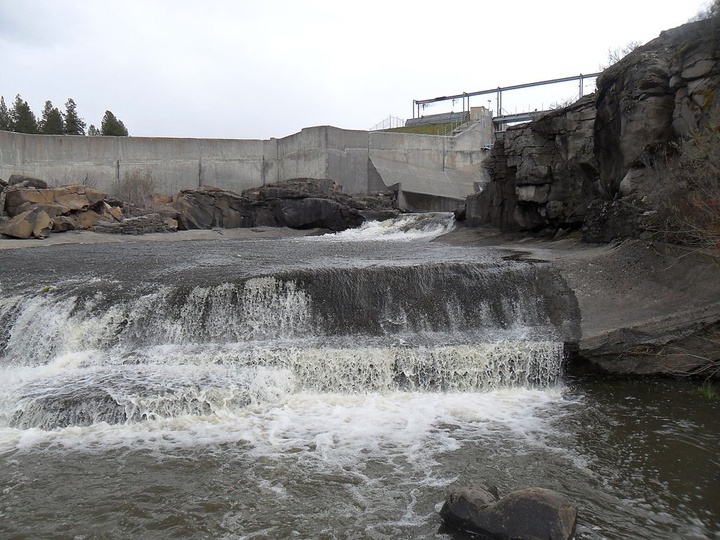Jessica Cejnar / Thursday, June 17, 2021 @ 1:03 p.m. / Environment
Federal Regulators Approve Klamath Hydroelectric Project License Transfer to KRRC, Recognizes Nonprofit's Ability to 'Undertake Dam Removal'

The J.C. Boyle Dam is one of four on the Klamath River slated for removal. Photo Bobjgalindo, via Wikimedia Commons. Public Domain.
Previously:
• Klamath River Renewal Corporation Hires Contractor To Spearhead Post-Dam Removal Habitat Restoration
• 'A New Era For California Tribes'; Agreement Breathes New Life Into Klamath River Dam Removal
###
Federal regulators on Thursday agreed to transfer the license to operate the Lower Klamath Hydroelectric Project from the utility that owned it to the nonprofit corporation seeking to dismantle it.
The Federal Energy Regulatory Commission’s order to transfer the project license from PacifiCorp to the Klamath River Renewal Corporation — with Oregon and California serving as co-licensees — recognizes that KRRC “has the ability, financially and otherwise, to undertake dam removal.”
It’s a milestone that puts removal of four hydroelectric dams on the Klamath River back on track to begin in 2023, KRRC Community Liaison Dave Meurer told the Wild Rivers Outpost. The next step is for FERC to approve KRRC’s application to surrender the license to operate the hydroelectric project, he said.
“FERC is fully aware that our intent is to remove the dams,” Meurer said. “The fact that they approved the license and specifically said ‘KRRC has the ability to undertake dam removal,’ gives us a lot of optimism.”
Removing the J.C. Boyle, Copco No. 1, Copco No. 2 and Iron Gate dams is expected to improve water quality and temperature conditions on the Klamath River and allow its salmon runs access to 420 miles of spawning habitat, according to a Thursday news release from Congressman Jared Huffman’s office.
FERC’s Thursday decision comes about a year after it initially approved a partial transfer of the hydroelectric project’s license from PacifiCorp to KRRC. Under that July 2020 order, PacifiCorp would have remained on the license and would have been liable for dam removal’s costs and liabilities.
This was a nonstarter for the utility and wasn’t consistent with the 2016 Klamath Hydroelectric Settlement Agreement, Meurer said. Twenty-three different parties signed on to the settlement agreement, including PacifiCorp, the states of California and Oregon, local tribes, conservation and fisheries organization.
Following FERC’s partial transfer order last summer, PacifiCorp, Oregon, California, the Yurok and Karuk signed a memorandum of agreement in November that would retain the liability protections for the utility. Meanwhile, KRRC would go back to FERC and offer the states as co-licensees of the project instead of the utility.
“As we read FERC’s reasoning when they did not approve the original transfer request, part of their concern was KRRC is a nonprofit with fixed assets,” Meurer said. “We’re not a utility. We don’t have deep projects like a utility. They’re used to regulating utilities — we are a unique animal for them.”
In a statement following the November agreement, California Department of Fish and Wildlife Director Charlton Bonham said the states signing on to the project as co-licensees ensures it has sufficient backing to achieve the settlement agreement’s goals.
With FERC’s approval of the license transfer achieved, KRRC is now focusing on getting the commission to approve its application to surrender the hydroelectric project’s license, Meurer said. That effort will have to undergo environmental review under the National Environmental Policy Act, which includes public comment periods, he said.
KRRC submitted several environmental documents to FERC, including 401 Water Quality Certifications from Oregon and California, Meurer said.
The process also requires biological opinions from the U.S. Fish and Wildlife Service and the National Marine Fisheries Service, Meurer said. KRRC also needs a 404 Clean Water Act permit from the U.S. Army Corps of Engineers, he said.
FERC’s decision to transfer the Klamath Hydroelectric Project license to KRRC on Thursday drew applause from Huffman.
“The tribes and stakeholders of the Klamath River basin have worked diligently for years to restore one of the West’s most important watersheds and now FERC has moved to make this a reality,” Huffman said in a written statement. “The partnerships between the states, the tribes, the utility and many others are ringing in a new era that recognizes the injustices of the past and invests in the future.”
According to Huffman, the dam removal project gained support from U.S. Interior Secretary Deb Haaland who filed a letter with FERC last week urging it to approve the transfer application.
“Today we have an incredible opportunity to restore this magnificent river, rewrite a painful chapter in our history and do so in a manner that protects the many interests in the basin,” Haaland wrote.
The four dams that make up the hydroelectric project do not contribute to water storage in the Klamath River Basin, Meurer told the Outpost. PacifiCorp has also been able to replace the electricity the dams generate, he said.
Removing the dams is expected to cost about $434 million. KRRC has a project budget of $450 million with $200 million coming from a PacifiCorp surcharge to its California and Oregon customers and $250 million coming from California water bond dollars.
In 2019, KRRC hired Fairfield-based Kiewit Infrastructure West to spearhead dam removal. In February 2021, the nonprofit contracted with the Bellaire, Texas firm, Resource Environmental Solutions, to undertake habitat restoration work following dam removal.
Documents:
• FERC Order Approving Transfer of License
CLICK TO MANAGE